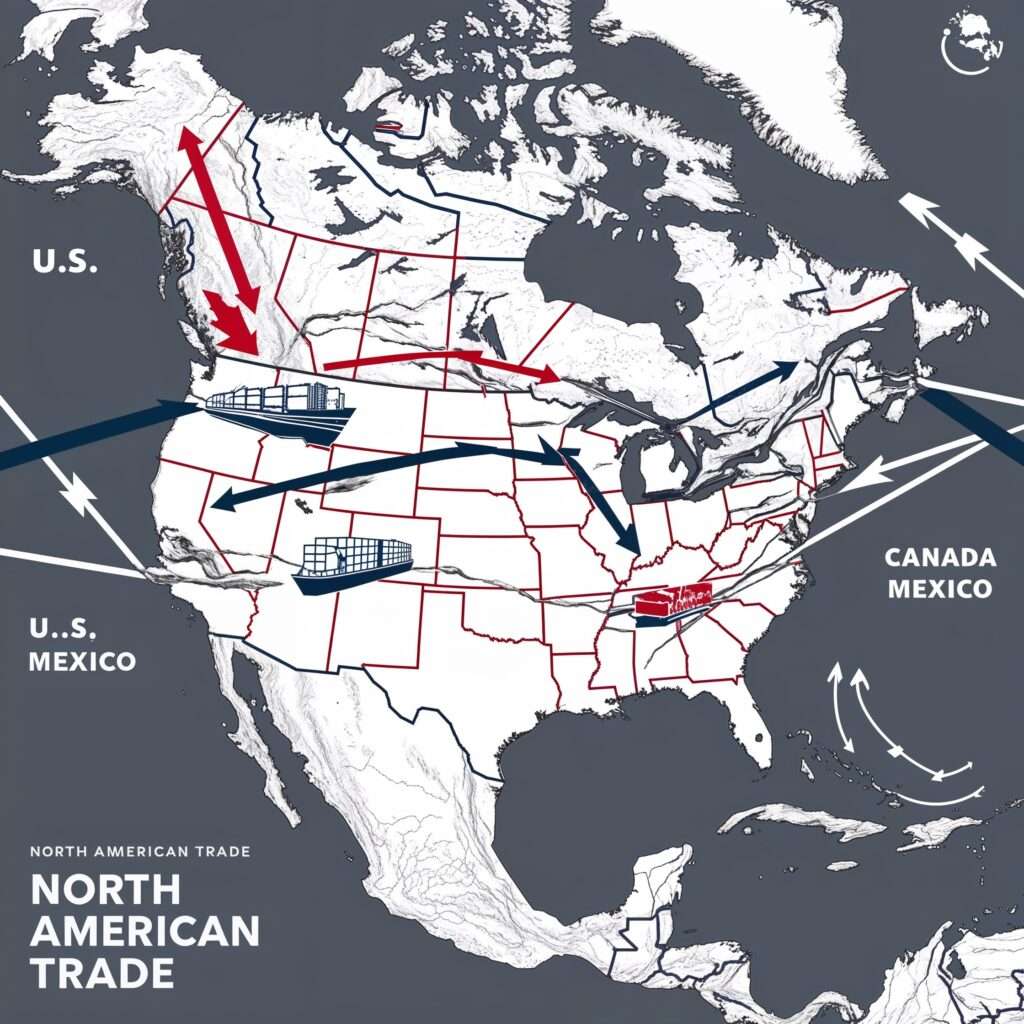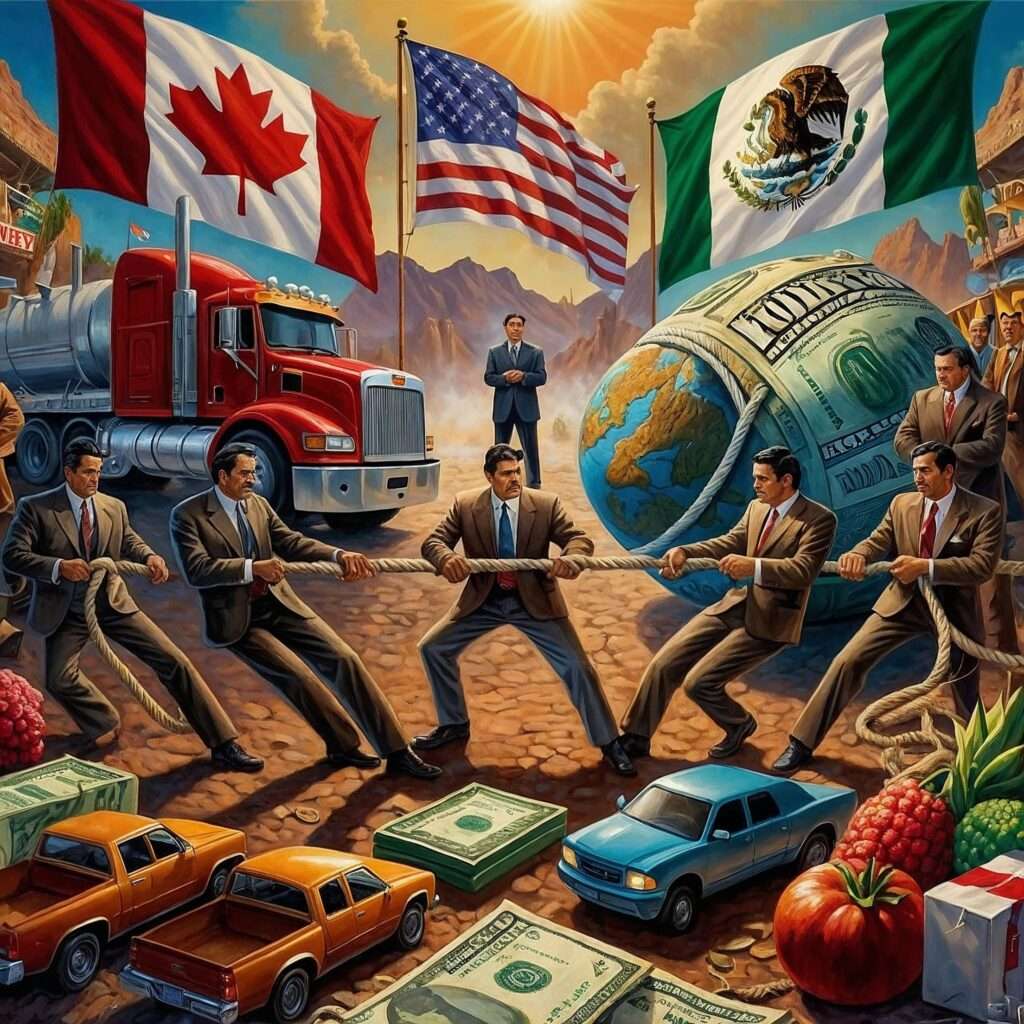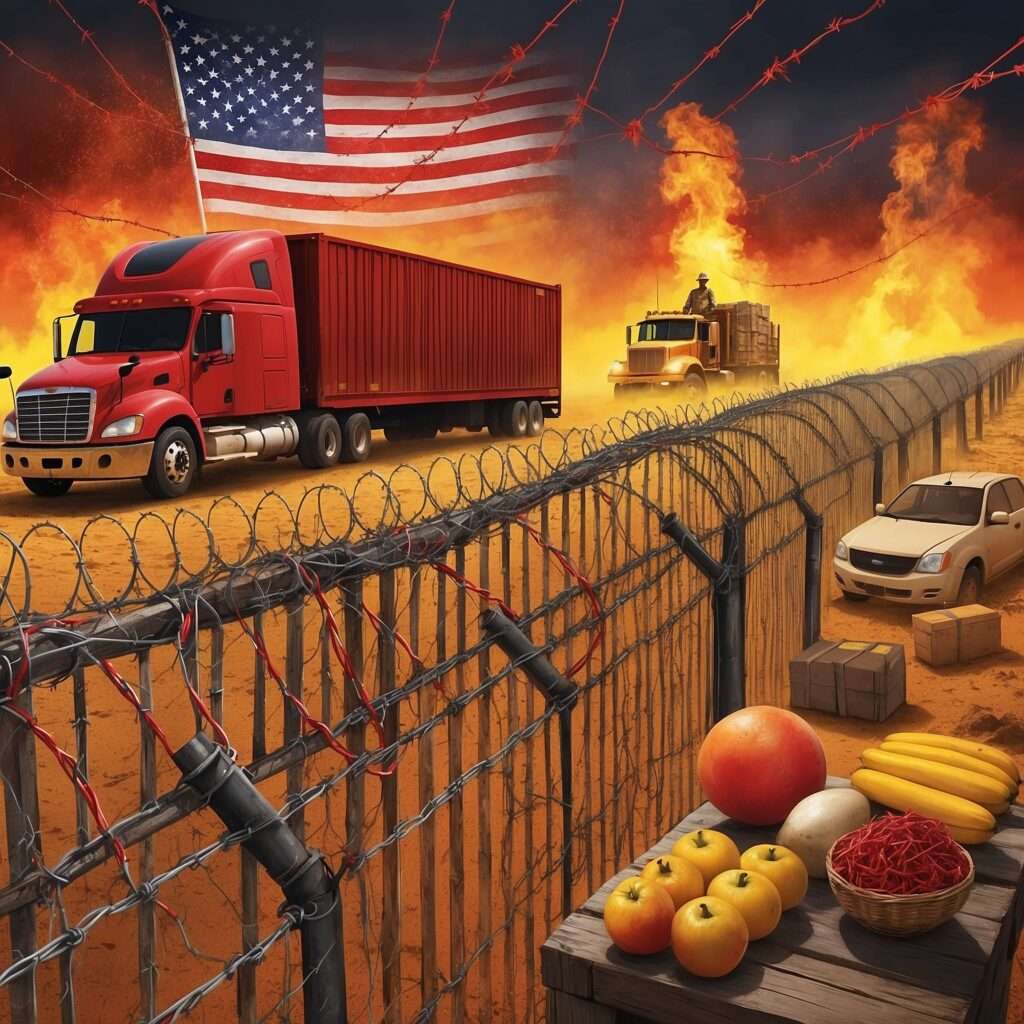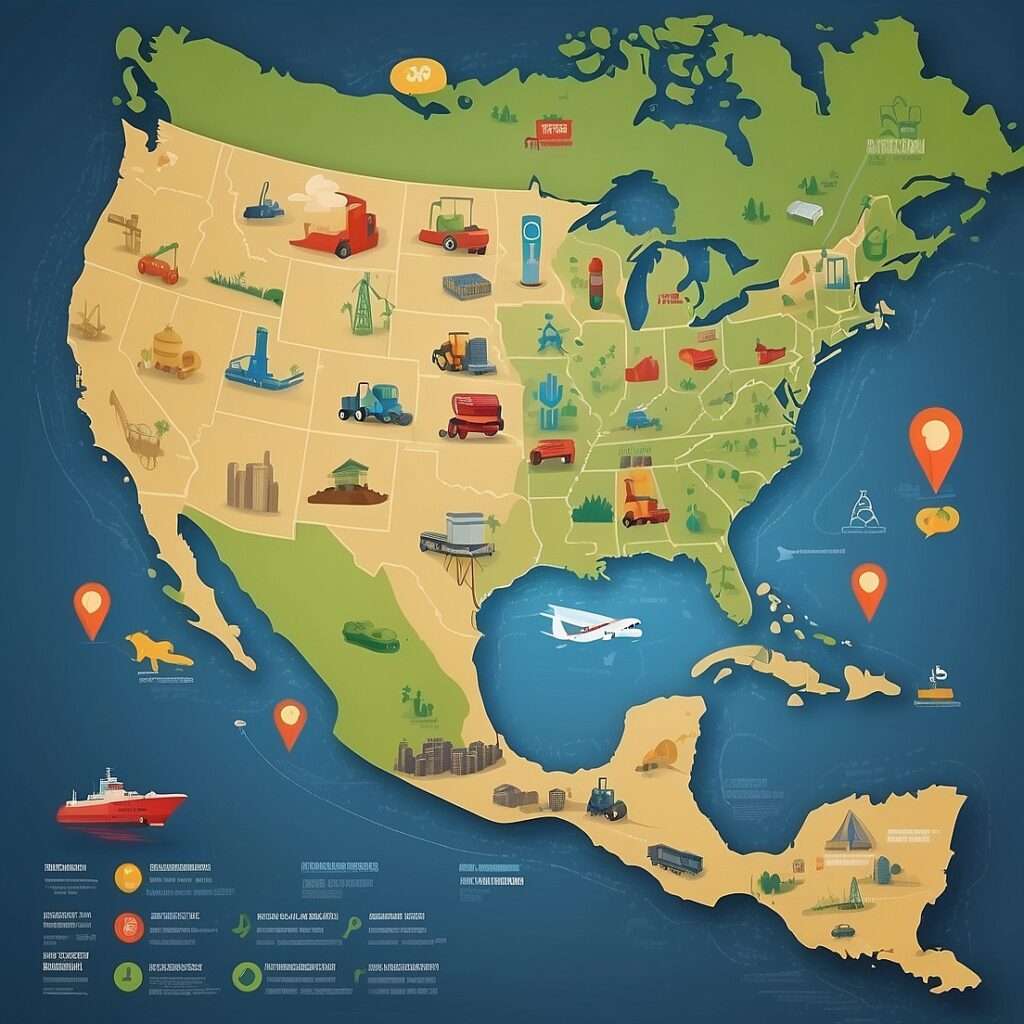
A visual representation of the trade tension between the U.S., Canada, and Mexico due to proposed tariffs.
Trump tariffs for Mexico and Canada—proposing a steep 25% on imports—have sparked intense debates about their sweeping economic consequences. With over $480 billion in annual trade at stake, this policy is more than a trade adjustment; it’s a high-stakes gamble that could reshape North America’s supply chains, consumer pricing, and international relationships.
The rationale behind these tariffs includes addressing illegal immigration, combatting the influx of fentanyl and drug trafficking, and stimulating domestic production by reducing reliance on foreign goods. While these objectives align with broader political goals, the potential ripple effects are far-reaching, threatening diplomatic ties with two of the U.S.’s largest trading partners and creating significant challenges for businesses and consumers.
This article explores the benefits and challenges of Trump tariffs for Mexico and Canada. From their potential to incentivize U.S. manufacturing to their impact on industries like agriculture and automotive, we’ll analyze how this policy could reshape trade, pricing, and economic stability across North America.
Why Trump Tariffs for Mexico and Canada Matter
Trump’s proposed tariffs on Mexico and Canada are not merely a financial mechanism—they are a strategic response to critical challenges faced by the U.S. economy and society. These include illegal immigration, drug trafficking, and the revitalization of domestic manufacturing.
1. Tackling Illegal Immigration
For decades, the U.S. has struggled with securing its southern border, with Mexico often playing a pivotal role in enforcement efforts. The administration views tariffs as an economic tool to push Mexico toward stricter border policies. Tariffs add financial urgency to cooperation, but this approach risks straining diplomatic relations with a vital partner in border security.
Critics warn that such economic coercion could lead to diplomatic fallout, jeopardizing existing collaborative efforts on immigration control. Furthermore, Mexico’s political response could complicate U.S. strategies, creating a divide in regional relations that would be difficult to bridge.
2. Combating Drug Trafficking
The U.S. is in the grips of a public health crisis fueled by synthetic opioids, particularly fentanyl. Mexico is a key transit point for these substances, and tariffs are positioned as a way to pressure Mexican authorities into dismantling trafficking networks.
However, experts argue that tariffs do not target the cartels responsible for the trade. Instead, they disrupt legitimate commerce, affecting businesses that are often unrelated to the drug trade. Without direct enforcement strategies, this approach risks being ineffective while adding unnecessary strain to economic ties.
3. Encouraging Domestic Manufacturing
Reviving U.S. manufacturing is central to the rationale for tariffs on Mexico and Canada. By making imported goods more expensive, tariffs create an environment where U.S.-made products can compete more effectively. This aligns with the administration’s “America First” agenda, which seeks to reduce dependency on foreign goods.
However, transitioning to domestic production is not immediate. Industries like electronics and automotive manufacturing require years of investment in infrastructure, technology, and workforce development. Without these elements, the U.S. risks falling short of its self-reliance goals.

Benefits of Trump Tariffs for Mexico and Canada
While controversial, Trump tariffs for Mexico and Canada have potential upsides that could reshape trade dynamics and boost the U.S. economy.
1. Trump Tariffs as a Bargaining Tool with Neighbors
The U.S. is the largest trading partner for both Mexico and Canada, creating significant leverage. Tariffs place financial pressure on these nations to address U.S. concerns such as immigration and drug enforcement.
For example, the United States-Mexico-Canada Agreement (USMCA) integrates supply chains across industries like agriculture, manufacturing, and automotive production. Disrupting these chains through tariffs forces Mexico and Canada to consider concessions to protect their economies.
However, this is a high-risk strategy. While it may yield short-term compliance, it risks creating long-term trade instability. Retaliatory measures could disrupt economic growth across all three nations.
2. Boosting U.S. Manufacturing with Tariffs
Tariffs aim to reduce reliance on foreign goods by incentivizing domestic production. Industries like automotive, textiles, and electronics are particularly poised to benefit:
- Automotive Manufacturing: Higher tariffs on imported vehicles and parts could compel companies to reopen U.S. factories, creating jobs in key states like Michigan, Ohio, and Pennsylvania.
- Textiles and Electronics: Rising import costs create opportunities for domestic producers to capture market share, especially for price-sensitive goods.
However, domestic manufacturers must invest in automation, training programs, and supply chain optimization to meet increased demand. Without these investments, imported goods may still dominate the market despite higher prices.
3. Strengthening Economic Independence via Tariffs
The COVID-19 pandemic exposed the fragility of global supply chains, highlighting the dangers of overdependence on imports. Tariffs provide an opportunity to strengthen U.S. resilience by encouraging local production of critical goods.
For instance:
- Semiconductors: The U.S. remains dependent on foreign semiconductor production, a vulnerability for industries ranging from electronics to defense. Tariffs could accelerate domestic chip manufacturing, securing national security interests.
- Agriculture: Increasing tariffs on imported produce, such as tomatoes and avocados, could incentivize U.S. farmers to expand domestic crop production. However, scaling up agriculture requires addressing labor shortages and investing in water-efficient technologies.
While this push for self-reliance is ambitious, achieving it requires long-term policy stability and substantial infrastructure investments.

Challenges of Trump Tariffs for Mexico and Canada
Trump’s proposed tariffs may offer leverage, but they also pose significant challenges that could ripple across industries, consumers, and the broader economy. Here’s a deeper dive into the obstacles associated with this policy:
1. The Risk of Retaliation to Trump Tariffs
Both Canada and Mexico have strongly suggested they will respond to tariffs with retaliatory measures, creating a cycle of economic conflict. For example:
- Mexico: As one of the largest buyers of U.S. agricultural products, Mexico could impose tariffs on corn, soybeans, pork, and dairy exports, key staples for American farmers. This could drastically hurt rural economies dependent on Mexican markets.
- Canada: Canada might target U.S. exports of aluminum, steel, and agricultural goods, mirroring its approach during previous tariff disputes under the Trump administration.
Such retaliation could escalate into a full-scale trade war, where both sides suffer economic losses. Industries like automotive, agriculture, and manufacturing—already sensitive to global market fluctuations—would face heightened uncertainty and potential layoffs, especially in border states heavily reliant on trade.
2. How Tariffs Raise Costs for U.S. Consumers
Tariffs act as an indirect tax on American consumers. When import costs rise, businesses often pass those expenses on in the form of higher prices for goods. Consider the following:
- Automotive Sector: Many vehicles sold in the U.S. rely on components imported from Mexico and Canada. A 25% tariff could add $1,000–$3,000 to the cost of a new car, making it harder for middle-class families to afford vehicles.
- Electronics: Products like televisions, smartphones, and household appliances, which rely heavily on imported components, could see price hikes of 15-30%, disproportionately impacting low-income households.
- Groceries: Essential imports like tomatoes, avocados, and other fresh produce from Mexico could become luxury items for some consumers, as prices surge due to increased import costs.
Low-income households, which already spend a higher percentage of their income on necessities, would bear the brunt of these price increases. This exacerbates economic inequality, making tariffs a politically contentious policy.
3. Disrupting North American Supply Chains
The economies of the U.S., Canada, and Mexico are tightly interconnected, particularly in sectors like manufacturing and agriculture. Integrated supply chains often depend on seamless cross-border collaboration. Here’s how tariffs disrupt this system:
- Automotive Industry: Cars assembled in the U.S. often use parts manufactured in Mexico and Canada. These components can cross borders multiple times during production. A 25% tariff would inflate costs at each stage, forcing automakers to either pass costs to consumers or cut production.
- Agriculture: American farmers rely on fertilizers, machinery, and labor sourced from Mexico and Canada. Tariffs could delay shipments, disrupt planting schedules, and increase production costs, ultimately reducing profitability.
- Electronics Manufacturing: Many consumer electronics rely on assembly lines spanning the three countries. Tariffs would add complexity and cost to these operations, pushing some companies to relocate production overseas to minimize disruptions.
The result is not just economic inefficiency but also a potential loss of jobs in industries that rely on predictable supply chain dynamics.
4. Challenges in Scaling U.S. Production
While the goal of tariffs is to boost domestic production, the reality is far more complex. Many industries lack the capacity to replace imports from Canada and Mexico in the short term. Here’s why:
- Agriculture: Producing enough fruits and vegetables domestically to replace imports would require substantial investment in land, labor, and irrigation infrastructure. Labor shortages, already a concern in the agricultural sector, would further exacerbate these challenges.
- Manufacturing: Building factories, sourcing raw materials, and training a skilled workforce take years. For example, producing consumer electronics or automotive components domestically requires advanced technologies that many U.S. companies currently lack.
- Cost Comparisons: Even with tariffs, domestic production might still be more expensive than importing goods, particularly for industries reliant on low-cost labor, such as textiles or assembly work.
Without significant infrastructure and policy investments, U.S. industries may struggle to fill the gap left by reduced imports. This delays the intended benefits of tariffs and raises questions about their long-term effectiveness.

U.S. Imports from Mexico and Tariff Impact
In 2023, the U.S. imported $480 billion worth of goods from Mexico, making Mexico one of the country’s most critical trading partners. These imports span several essential industries:
Key Categories of Imports:
- Automobiles and Auto Parts:
More than 30% of vehicles sold in the U.S. depend on parts manufactured in Mexico. From engines to wiring systems, Mexico plays a vital role in North America’s automotive supply chain. A tariff on these goods would drastically increase production costs for automakers, potentially adding $1,000–$3,000 to the price of a new car. - Electronics:
Mexico is a leading supplier of smartphones, televisions, household appliances, and computer components.Many U.S. companies rely on affordable assembly in Mexico to remain competitive in global markets. A 25% tariff could disrupt this dynamic, forcing price increases on essential goods. - Agriculture:
Mexico supplies over 70% of fresh produce like avocados, tomatoes, and berries consumed in the U.S. These products are staples for American households, and higher import costs could push prices beyond the reach of many consumers, especially in lower-income demographics. - Machinery:
Essential equipment for industrial and manufacturing processes is often sourced from Mexico. Tariffs on these imports could impact productivity across various industries, from construction to energy production.
The Impact of a 25% Tariff
If implemented, a 25% tariff would lead to significant price hikes across these key categories. The automotive sector would face particularly steep challenges, as parts and vehicles often cross the border multiple times during production. Manufacturers would need to raise prices to offset increased costs, hitting consumers and reducing demand. Similarly, fresh produce prices could surge by 15-30%, placing additional strain on households already battling inflation.
Domestic Production vs. Trump Tariffs
While the goal of tariffs is to incentivize domestic production and reduce dependency on imports, the reality is more complicated:
1. Agriculture
Encouraging American farmers to grow more crops domestically sounds appealing but faces significant obstacles:
- Labor Challenges: Crops like avocados and berries are labor-intensive, requiring a large, affordable workforce that the U.S. agricultural sector currently lacks.
- Water Scarcity: Many of these crops require consistent irrigation, which is difficult to sustain in drought-prone regions like California and the Southwest.
- Higher Production Costs: Domestic farming comes at a premium compared to Mexico, where labor and climate conditions provide a cost advantage.
2. Manufacturing
Building the infrastructure to replace Mexican imports in sectors like electronics and automotive parts would take years and require massive investments. Challenges include:
- Factory Construction: Establishing advanced manufacturing facilities involves high capital costs and long timelines.
- Skilled Labor Shortages: The U.S. currently faces a shortage of trained workers in manufacturing fields, particularly for high-tech production.
- Uncertainty: Businesses may hesitate to invest in domestic production due to the unpredictability of long-term trade policies and tariff durations.
Short-Term Implications
While domestic production is a noble goal, the transition would not be immediate. In the short term, goods shortagesand increased consumer prices are likely. This could burden American households and businesses before the benefits of reshoring can be realized.
Economic Ramifications of Trump Tariffs on Mexico and Canada
The proposed tariffs carry significant economic and political risks that extend far beyond trade numbers. Here are two critical areas of concern:
1. Diplomatic Strains
The United States-Mexico-Canada Agreement (USMCA) was designed to promote economic collaboration across North America. However, imposing tariffs could erode the goodwill fostered by the agreement, creating tensions among the three nations. For instance:
- Mexico: Tariffs may strain Mexico’s willingness to cooperate on immigration and drug trafficking, two areas where the U.S. depends heavily on Mexican support.
- Canada: Canada could view these tariffs as a violation of USMCA commitments, potentially retaliating with measures that impact U.S. exports.
2. Shifting Alliances
Both Mexico and Canada may respond to tariffs by strengthening trade relationships with global powers like China or the European Union. This could reduce the U.S.’s influence in North America and weaken its economic position in the global arena. Additionally, diversification of trade routes could lead to long-term damage to U.S. export markets.
Conclusion: A Double-Edged Sword
Trump’s proposed 25% tariffs on Mexico and Canada present a bold strategy with clear goals: reducing illegal immigration, combating drug trafficking, and revitalizing domestic production. However, the risks cannot be ignored. From potential trade wars and price hikes to supply chain disruptions and strained diplomatic ties, these tariffs could create as many problems as they aim to solve.
While tariffs may encourage self-reliance and domestic growth in the long run, their immediate impact could burden American consumers and businesses. To avoid these pitfalls, policymakers should consider alternatives such as diplomatic negotiations and targeted incentives for U.S. industries. Balancing these tools could lead to a more sustainable and equitable solution to the challenges at hand.
Darwin’s Take: Tariffs as Theater
Trump’s proposed 25% tariffs on Canada and Mexico are less about economics and more about optics. They’re not designed to fix the flow of migrants or drugs—they’re a blunt political spectacle, aimed at projecting strength while kicking the can of real solutions further down the road.
In practice, these tariffs risk imploding North America’s fragile economic ecosystem. Supply chains fracture, prices surge, and retaliatory tariffs escalate tensions. Meanwhile, domestic production won’t scale overnight; it’s a pipe dream sold as policy.
The truth? This isn’t economic strategy—it’s economic brinkmanship. The collateral damage? American consumers, businesses, and long-term regional stability. Like most gambles, the house rarely wins.
Sources
- U.S. Imports from Mexico (2023 Data)
- Details on Trump’s Tariff Proposal
- USMCA Overview and Trade Impacts
- Economic Retaliation by Mexico and Canada
- Analysis of Domestic Production Capacity
- Impact of Tariffs on Consumer Prices
- Trump’s Economic Policy Approach
Further Reading on Paranoid Prophet
For further insights into the political landscape and its intricate dynamics, explore these articles:
- Politics Archives – Paranoid Prophet
Explore a curated collection of thought-provoking articles that dissect the political dynamics shaping our world. From in-depth analyses of policy decisions to the strategies of influential leaders, this archive offers a comprehensive look at the forces driving modern governance and power struggles. Perfect for readers seeking a deeper understanding of the intersection of politics, economics, and societal impact. - Donald Trump’s Complete List of 2024 Interviews, Podcasts, and Campaign Events
Delve into an exhaustive compilation of Donald Trump’s media engagements and rallies throughout his 2024 presidential campaign. - Kamala Harris’s Post-Campaign Announcement Media Appearances: A Complete Guide for Voters
Examine a detailed guide to Kamala Harris’s media appearances following her 2024 campaign announcement, offering voters comprehensive insights.
These articles provide a deeper understanding of the current political climate and the strategies employed by key figures.
FAQ: Trump Tariffs for Mexico and Canada
1. What are Trump tariffs for Mexico and Canada?
Trump tariffs for Mexico and Canada refer to the proposed 25% tariff on goods imported from these countries. The policy aims to address issues such as illegal immigration, drug trafficking, and promoting domestic manufacturing by making foreign goods more expensive.
2. How much does the U.S. import from Mexico and Canada?
In 2023, the U.S. imported approximately $480 billion worth of goods from Mexico and $400 billion from Canada.These imports include key goods like automobiles, electronics, agricultural products, and machinery.
3. Why were these tariffs proposed?
The proposed tariffs aim to:
- Pressure Mexico to strengthen its border policies and combat drug trafficking.
- Reduce U.S. reliance on foreign imports by incentivizing domestic production.
- Leverage economic power to encourage compliance with U.S. political and trade priorities.
4. What industries would be most affected by these tariffs?
Key industries that would be heavily impacted include:
- Automotive: Many parts and vehicles are sourced from Mexico and Canada, making this sector vulnerable to cost increases.
- Agriculture: The U.S. imports large quantities of fresh produce like avocados and tomatoes from Mexico.
- Electronics: Canada and Mexico are major suppliers of smartphones, appliances, and other electronic components.
- Machinery: Industrial equipment from these countries is critical to manufacturing processes in the U.S.
5. What is the impact of Trump tariffs on U.S. consumers?
The tariffs would likely increase prices on goods imported from Mexico and Canada, such as cars, fresh produce, and electronics. These price hikes could range from 15-30%, disproportionately affecting lower-income households that spend a larger share of their income on essential goods.
6. How do tariffs affect U.S.-Mexico-Canada relations?
Tariffs could strain diplomatic ties and undermine the United States-Mexico-Canada Agreement (USMCA), which was designed to promote free trade. Additionally, Canada and Mexico might retaliate with tariffs on U.S. goods, potentially leading to a trade war.
7. Do tariffs help domestic production?
Tariffs can encourage domestic production by making imported goods more expensive, thus incentivizing companies to manufacture locally. However, scaling up domestic production requires significant investments in factories, workforce training, and infrastructure, which may take years to achieve.
8. How could Canada and Mexico retaliate?
Both countries have indicated that they could impose retaliatory tariffs on U.S. exports, particularly targeting industries like:
- Agriculture: U.S. corn, soybeans, and pork exports could face higher tariffs.
- Metals and Energy: Canada might target steel, aluminum, or energy exports.
- Consumer Goods: Retaliation could extend to products like electronics or machinery.
9. Are there alternatives to tariffs for achieving the same goals?
Yes, alternatives include:
- Diplomatic negotiations: Strengthening border security and drug enforcement agreements with Mexico and Canada.
- Incentives for U.S. manufacturing: Providing tax breaks or subsidies to encourage domestic production.
- Enhanced trade policies: Reforming the USMCA to include stricter compliance measures for immigration and anti-drug initiatives.
10. What is the long-term impact of Trump tariffs?
In the long term, the tariffs could:
- Encourage U.S. economic self-reliance by boosting domestic production.
- Shift global trade alliances as Mexico and Canada seek stronger relationships with other countries.
- Lead to higher prices for U.S. consumers and businesses until domestic industries can meet demand.
Call to Action
Have more questions about the Trump tariffs for Mexico and Canada? Let us know in the comments below or explore more articles in our Politics section for detailed insights!


